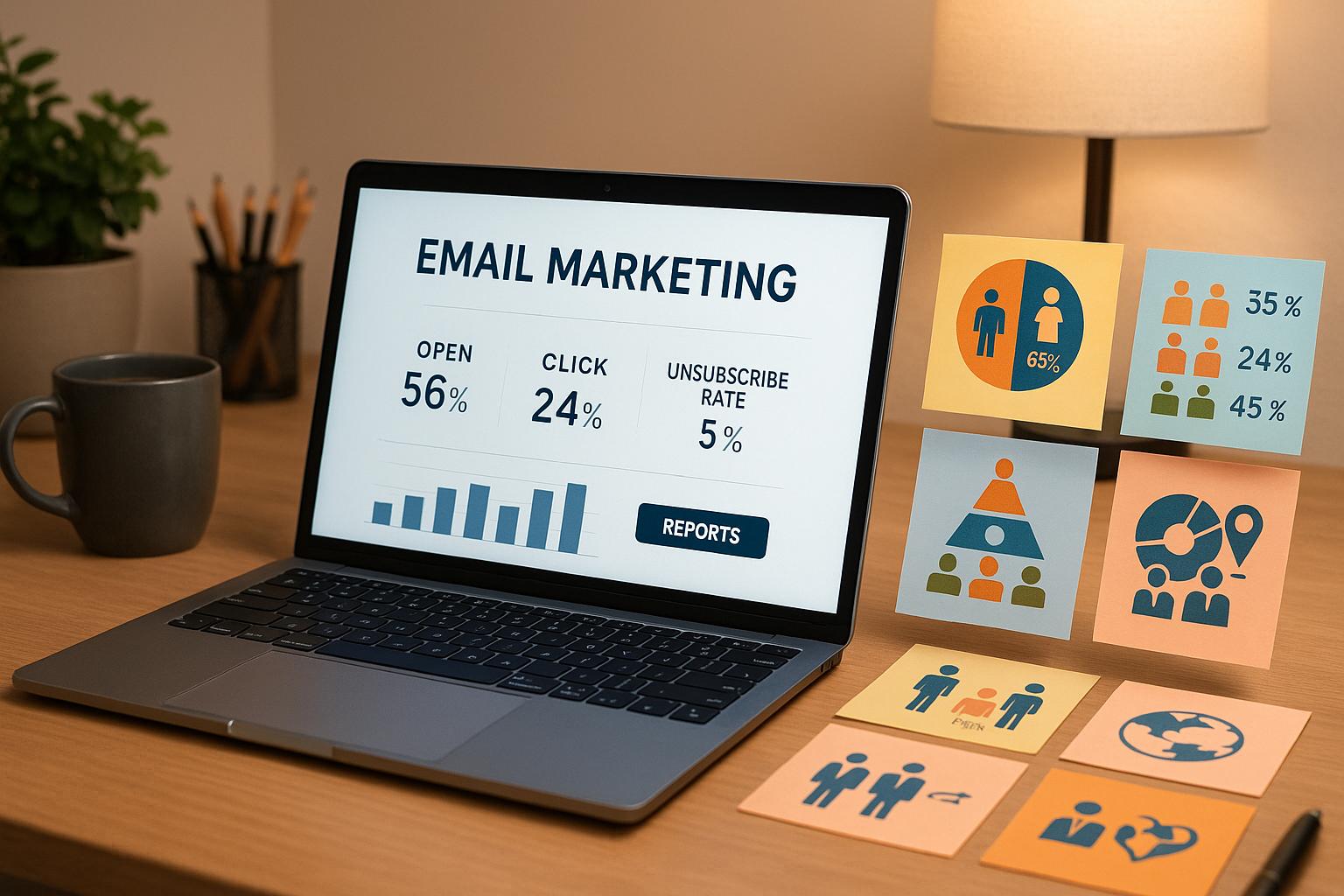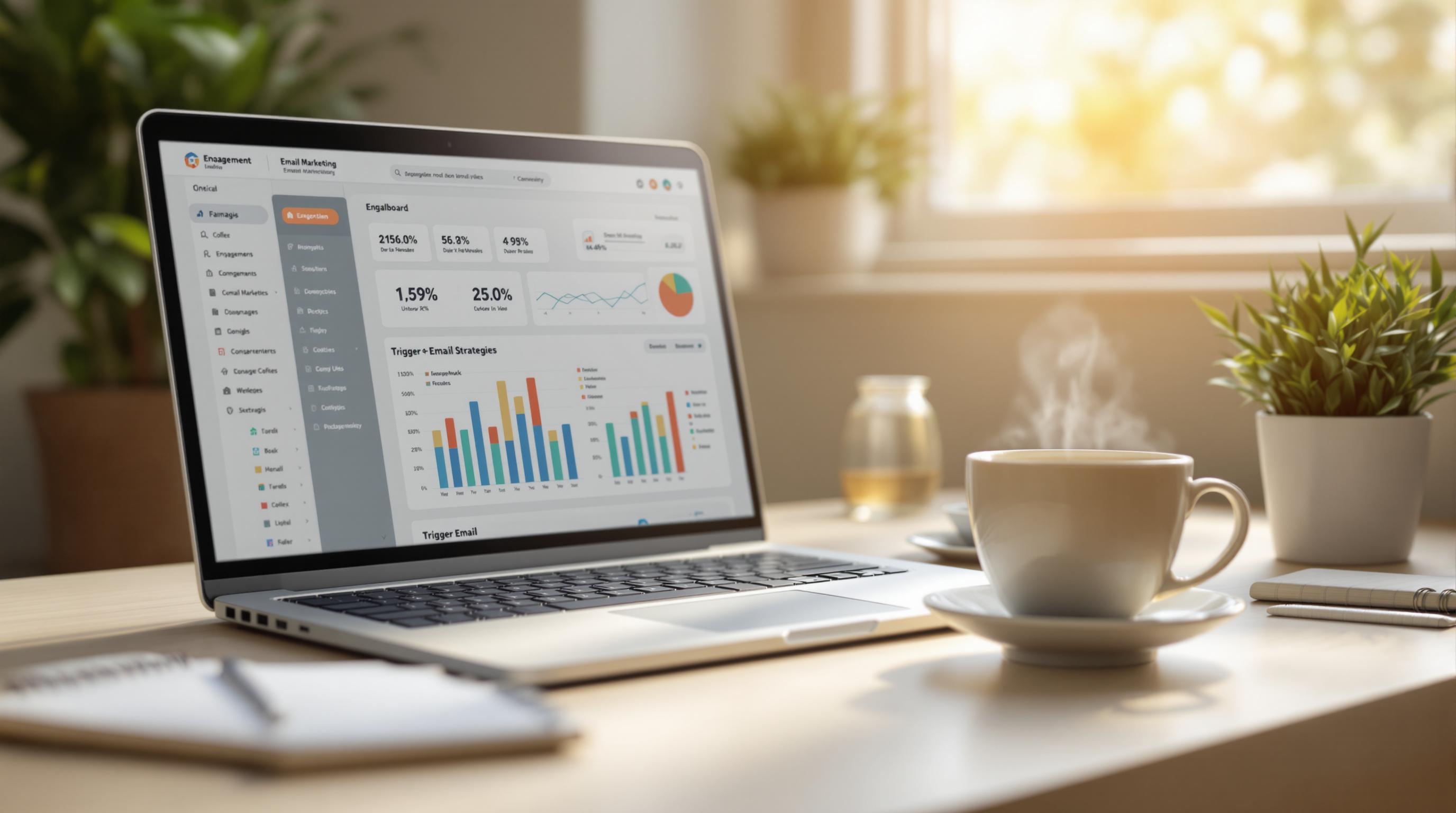Want to turn app downloads into engaged users? Cross-channel messaging is key. By combining email, push notifications, and in-app messages, you can guide users through the conversion funnel and boost retention. Each channel has a unique role:
- Email: Great for detailed communication and reactivating users.
- Push Notifications: Perfect for quick actions and time-sensitive updates.
- In-App Messaging: Engages active users with real-time guidance.
The secret is timing. Use email for onboarding, push notifications for reminders, and in-app messages for contextual help. Together, these tools create a coordinated user journey that improves conversions and keeps users coming back. Want to refine your email strategy? Check out tools like the Email Service Business Directory for seamless integration.
Top CRO Strategies for Mobile Apps
1. Email
Email serves as the backbone of any cross-channel messaging strategy. It provides a broad reach and a high degree of personalization, making it an essential tool for connecting with users. Unlike other channels that rely on app installations or enabled notifications, email cuts through these barriers by reaching users directly through their inbox. This makes it particularly powerful for reactivating dormant users and nurturing leads that haven’t yet converted.
One of email’s biggest strengths is its ability to deliver detailed, in-depth content. Whether it’s showcasing product demos, explaining features, sharing testimonials, or including visuals that highlight an app’s value, email allows for a level of depth that other channels simply can’t match.
Engagement Rate
The success of email campaigns hinges on how well messages are tailored to the audience. Segmented and personalized emails consistently outperform generic, one-size-fits-all blasts. Timing also plays a key role in engagement. Studies suggest that emails sent on midweek mornings or early afternoons often perform better, although the ideal timing can vary depending on the audience.
Conversion Impact
Email doesn’t just drive clicks - it plays a critical role in boosting app conversions when used alongside other channels. For example, abandoned cart recovery emails in e-commerce demonstrate how timely communication can encourage users to return and complete their purchases. When paired with push notifications, these emails become even more effective. Similarly, onboarding emails can guide new users through initial setup, increasing activation rates and reducing churn.
Best-Use Cases
Email shines in scenarios that require detailed communication. Announcing new features? Use email to include screenshots, video demos, and clear explanations that help users grasp the value of updates. Trying to re-engage inactive users? Personalized campaigns can reignite their interest. Educational series like tutorials, tips, or industry insights also work well, helping to build trust and position your app as a go-to resource over time.
For businesses aiming to refine their email marketing as part of a cross-channel strategy, tools like the Email Service Business Directory can help compare platforms that excel in integration, automation, and multichannel coordination. With email as a strong foundation, the next step is to explore how push notifications can complement this strategy by driving immediate user actions. Stay tuned for more on that.
2. Push Notifications
Push notifications grab attention by appearing directly on users' screens, making them perfect for driving quick actions. Unlike emails, which people often check at their convenience, push notifications deliver a sense of urgency and immediacy.
Because of strict character limits, these notifications require marketers to get straight to the point, sharing only the most critical information.
Engagement Rate
The success of push notifications depends heavily on timing, personalization, and how often they’re sent. Personalized messages consistently perform better than generic ones. However, too many notifications can annoy users, leading to app uninstalls. Notifications triggered by specific actions - like reminding users about an abandoned cart or celebrating an in-app achievement - tend to drive more engagement compared to scheduled, generic messages.
Conversion Impact
Push notifications are excellent for sparking quick conversions, especially when paired with other outreach methods like email. For example, a push notification sent shortly after a user abandons their cart can nudge them to complete the purchase. In gaming, reminders about unclaimed rewards or unfinished challenges keep users engaged and motivated.
Location-based push notifications are especially effective for industries like retail or food delivery. By using a user’s proximity to stores or restaurants, these notifications can prompt immediate action. Additionally, sending a notification soon after a user’s app session often leads to better engagement than waiting too long.
Best-Use Cases
Push notifications shine in time-sensitive situations. Breaking news, sports score updates, and flash sale alerts are all examples where speed is essential.
For onboarding, a thoughtful approach works best. Instead of bombarding new users with notifications right after they install the app, many successful apps wait, allowing users to explore first before sending their first message. Similarly, re-engagement campaigns often begin with a push notification and follow up with an email if the user doesn’t respond quickly.
For apps that focus on goals or achievements, notifications highlighting progress or celebrating milestones can motivate users to stay engaged. The most effective strategies treat push notifications as part of a bigger communication plan, working alongside email, in-app messages, and other channels. Up next, we’ll look at how in-app messaging can strengthen user engagement.
sbb-itb-6e7333f
3. In-App Messaging
In-app messaging connects with users while they're actively engaged in your app, offering a direct and timely way to interact. These messages - whether they appear as overlays, banners, or pop-ups - help guide users toward specific actions without feeling overly disruptive. They fit naturally into a broader cross-channel strategy, enhancing the overall user experience.
Unlike push notifications that battle for attention on crowded lock screens, in-app messages target a more focused audience. Since users are already immersed in your app, they’re more likely to pay attention and respond. This makes in-app messaging a powerful tool for driving both engagement and conversions.
Engagement Rate
In-app messaging shines when it comes to engagement rates, especially when used as part of a coordinated messaging strategy. By leveraging contextual timing and behavioral triggers, these messages can feel highly relevant. For instance, if a user spends time exploring a premium feature but hasn’t upgraded, a well-placed message explaining the benefits can prompt action. Similarly, after a user completes their first successful action in the app, introducing additional features can keep their momentum going.
A gradual approach, often called progressive disclosure, helps maintain engagement without overwhelming users. Instead of presenting every feature at once, successful apps reveal them step by step, allowing users to grow comfortable with the platform. This method not only keeps users engaged but also builds their confidence.
The design of in-app messages plays a huge role in their effectiveness. Messages that align with the app’s overall design feel more organic and less intrusive. Additionally, clear and actionable buttons with specific calls-to-action - like "Start Free Trial" or "See Pricing" - tend to perform better than generic options like "Learn More."
Conversion Impact
In-app messaging is particularly effective at driving conversions by addressing hesitation in real time. For example, onboarding sequences delivered through in-app messages can significantly improve user conversion rates. Instead of overwhelming new users with all the app’s features at once, progressive onboarding introduces them as needed, helping users discover value quickly and reach their "aha moment."
E-commerce apps, in particular, see success with cart abandonment recovery through in-app messaging. If users add items to their cart but don’t complete the checkout process, a well-timed reminder - perhaps including social proof or a limited-time offer - can encourage them to finish the purchase.
In-app messages are also perfect for upselling and cross-selling. When users complete an action and are feeling positive about their experience, they’re more open to exploring additional features or making purchases. By capitalizing on this momentum, apps can drive further conversions.
Best-Use Cases
In-app messaging is ideal for feature discovery. When users aren’t taking advantage of key features that could improve their experience, these messages serve as timely nudges, complementing email and push notifications by offering immediate guidance.
For feedback collection, in-app messaging captures users’ thoughts while their experience is still fresh. Asking for a rating after a successful task or requesting feedback after an issue ensures more honest and actionable responses.
Subscription and upgrade prompts work particularly well when tied to user behavior. Instead of sending generic upgrade messages, apps can display prompts when users hit usage limits or attempt to access premium features. This creates a natural link between the message and the user’s intent.
Announcements and updates are another strong use case. Whether you’re introducing new features or explaining important changes, in-app messages ensure users can immediately explore updates or understand how they’ll impact their experience.
When used alongside email and push notifications, in-app messaging helps create a seamless cross-channel communication strategy. For example, an email might introduce a feature, a push notification can remind users to check it out, and an in-app message can guide them step-by-step in using it. This layered approach ensures consistent messaging while respecting user preferences across different channels.
Advantages and Disadvantages
Every messaging channel offers its own set of strengths and limitations, and understanding these trade-offs is crucial for shaping a successful cross-channel strategy. By carefully weighing these factors, you can allocate resources effectively and sequence your messaging to drive conversions.
Email stands out for its ability to deliver detailed and rich content that users can revisit anytime. Its long-lasting presence makes it ideal for sharing complex product details or educational content. However, email does have its challenges. Messages can end up in spam folders, and crowded inboxes contribute to declining open rates. Plus, its slower response time makes email better suited for nurturing relationships rather than driving immediate actions.
Push notifications grab attention instantly by appearing directly on users' screens. They excel at delivering urgent, concise messages that encourage quick actions. However, if overused, they can feel intrusive, leading users to disable notifications altogether. Additionally, the limited character space restricts how much information you can convey in a single message.
In-app messaging achieves the highest engagement rates because it reaches users while they’re already engaged with your app. These messages feel natural and contextual, making them perfect for real-time guidance and progressive disclosure. But there’s a catch - they only reach active users, leaving out those who’ve stopped using your app. This makes in-app messaging less effective for re-engagement campaigns.
Here’s a quick comparison of how these channels perform across key metrics:
| Channel | Engagement Rate | Conversion Impact | Best-Use Cases |
|---|---|---|---|
| Moderate (15–25% open rates) | High for nurturing, moderate for immediate action | Detailed onboarding, product education, weekly digests, device-specific reminders | |
| Push Notifications | High initially, but declines over time | High for time-sensitive actions | Flash sales, breaking news, appointment reminders, re-engagement |
| In-App Messaging | Highest among active users | Excellent for feature adoption | Feature discovery, upgrade prompts, contextual help, feedback collection |
When it comes to cost, each channel has different demands. Email requires ongoing list management and deliverability monitoring. Push notifications need careful frequency control to avoid opt-outs. In-app messaging, while requiring upfront development, tends to have lower ongoing costs.
The most effective strategies don’t rely on just one channel. Instead, they combine all three in a way that amplifies their strengths and minimizes their weaknesses. For instance, email lays the groundwork with detailed information, push notifications create urgency and drive app engagement, and in-app messaging guides users toward conversions once they’re active.
When planning your cross-channel strategy, think about your app’s user behavior, the complexity of your conversion funnel, and your available resources. Apps with intricate onboarding processes often benefit from email sequences, while simpler apps might see better results with push notifications. Matching your messaging channels to your goals and user preferences will help you fine-tune your strategy for maximum impact.
Conclusion
Cross-channel messaging plays a pivotal role in the success of mobile apps, as no single channel can meet every user need. Each channel serves a distinct purpose: email provides detailed and informative content, push notifications create a sense of urgency, and in-app messages engage users who are already active in the app.
The secret to effective messaging lies in careful planning, not random outreach. Start by mapping out the user journey to determine how each channel can deliver value at the right moment. For example, use email to onboard and educate new users with structured sequences. Turn to push notifications during critical moments like abandoned carts or time-sensitive offers. Meanwhile, in-app messages can guide engaged users toward specific actions, such as completing a tutorial or exploring new features. This thoughtful alignment ensures that timing becomes a crucial factor in driving conversions.
Timing and frequency are everything. A well-timed push notification can significantly boost conversions compared to one sent at the wrong moment. On the flip side, bombarding users with too many messages across all channels risks opt-outs - or worse, app deletions.
Crafting a successful strategy also means avoiding repetitive content. Instead, focus on how each channel can complement the others. For instance, email can introduce a new feature with detailed explanations, push notifications can serve as timely nudges, and in-app messages can offer contextual help right when it’s needed.
If you’re looking to enhance the email component of your cross-channel efforts, the Email Service Business Directory is a valuable resource. It features a curated list of email marketing platforms and providers, helping you find tools that integrate seamlessly with your push notification and in-app messaging strategies. This kind of integration ensures your messaging stays cohesive and effective.
Finally, measurement is the cornerstone of any cross-channel strategy. Track key metrics like conversion rates, engagement levels, and user progression across channels. Use this data to analyze how users respond to different messaging combinations and fine-tune your approach. The most successful apps continuously adapt their strategies based on real user behavior, ensuring their messaging remains relevant and impactful.
FAQs
How can I combine email, push notifications, and in-app messaging to boost user engagement and app conversions?
To make the most of email, push notifications, and in-app messaging, it’s all about weaving them into a cohesive and user-focused strategy. The key is to deliver messages that feel personalized and hit at just the right time, based on how users interact with your product.
Start by ensuring these communication channels work together rather than in isolation. For instance, push notifications are great for grabbing attention with time-sensitive updates, while email can dig deeper with detailed information or follow-ups. Meanwhile, in-app messaging shines when delivering timely, context-aware prompts while users are actively using your app.
When these channels are integrated thoughtfully, they create a smooth and engaging experience that keeps users interested and nudges them closer to taking action. To make this process even smoother, consider using tools or platforms that centralize your messaging efforts and provide real-time data to fine-tune your approach.
How can I time and personalize cross-channel messages to engage users without overwhelming them?
To time and personalize cross-channel messages effectively - without overwhelming your audience - focus on two key elements: consistency and relevance. Implement frequency caps to control how often users receive messages, preventing them from feeling bombarded across various platforms. Pair this with real-time data to craft messages that align with individual preferences and behaviors, making interactions feel tailored and meaningful.
Strive for balance by sharing only the most relevant information at each touchpoint. This approach keeps users engaged while reducing the risk of fatigue. When you deliver timely, targeted messages, you create a smooth, user-friendly experience that drives conversions without coming across as intrusive.
How can I track the success of my cross-channel messaging strategy and improve results?
To gauge how effective your cross-channel messaging is, keep an eye on key performance metrics such as conversion rates, engagement levels, revenue per message, and overall ROI. These numbers give you a clear picture of how well your strategy is working to boost mobile app conversions.
Dive deeper by analyzing audience behavior and preferences across different platforms. Automation tools can help you tailor messages and fine-tune content for each channel. Regularly testing and tweaking your approach ensures better engagement and stronger campaign results over time.


